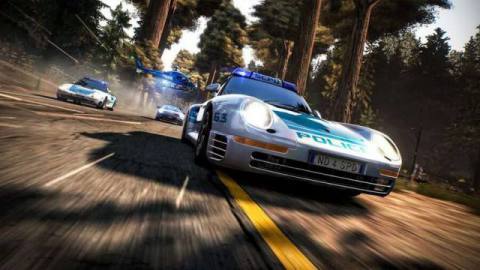
Nintendo Switch may have been slow off the starting line when it came to racers, ‘realistic’ or otherwise, but in the years since launch it’s slowly but surely built up a fine catalogue of racing games in addition to everyone’s favourite kart racing plumber. Criterion’s evergreen Burnout Paradise Remastered, for example, launched on Switch back in June this year, and Stellar Entertainment Software — a studio with several Criterion veterans and the same team responsible for that game — brought Need For Speed: Hot Pursuit Remastered to Switch and other consoles simultaneously earlier this month.
Back in the summer we spoke to them about Burnout, and prior to Hot Pursuit’s launch, we caught up once again with Creative Director Chris Roberts to find out a little more about the challenges of bringing this game to Switch alongside the other platform versions, the additions in this remaster, and how it compared to working on Stellar’s previous project.
Nintendo Life: Unlike Burnout Paradise Remastered, Hot Pursuit Remastered is launching on Switch at the same time as on other consoles. Has working on all the versions simultaneously been helpful for optimising for the Switch version?
Chris Roberts: Certainly working on them at the same time was beneficial but we learnt an awful lot during the work on the Switch version of Paradise which helped immensely.
How long has the game been in development?
About a year, and a large portion of that was during the first lockdown which created some pretty unique challenges for us to overcome. But the team has managed it all amazingly well with some fantastic help from EA and Criterion.
What’s been the biggest challenge of getting Hot Pursuit running smoothly on Nintendo’s console?
One of the Switch’s greatest strengths is that it can be played both on a TV and handheld, making it look good and play well in both scenarios was something that we paid close attention to throughout.

The game targets 1080p at 30fps on Switch. Were there discussions around reducing the resolution and shooting for a higher framerate with a ‘performance mode’ on Switch?
Our target was to get the Switch version as close to the PS4 and Xbox One versions as we could. A clear image and a rock solid frame rate were our priority and focus.
Cross-platform multiplayer is a huge boon for players everywhere, and the Autolog returns in the remaster, too. How was the process of overhauling and implementing this on modern systems?
It was a tremendous amount of work to resurrect the original systems, update them to support new modern network infrastructure and requirements and on top of that implement crossplay for four different platforms. We also managed to do all that with everyone largely working from home during a pandemic, so it was pretty epic.
It was a tremendous amount of work to resurrect the original systems, update them to support new modern network infrastructure and requirements and on top of that implement crossplay for four different platforms.
You’ve also introduced some quality of life updates and tweaks – can you tell us a little about them? Is there anything Switch-specific?
As development of the Switch was alongside all the other version of the game means all the decisions during the development always involved us making sure the change made sense for the Switch version. We have completely overhauled and rebuilt all the menu screens and HUD. added more event information on the career map so players can make more informed decisions. We have also added the ability to skip non-interactive scenes, improved visibility for night races (especially important when playing in handheld mode as the original game was very dark at night). We’ve also added a lot of additional signage to the world to help improve the readability of race routes and shorts (again super useful when playing in handheld mode).
How did the experience of revisiting this game compare with returning to Burnout Paradise?
With this and Paradise we refer to [them] as a type of video game archaeology. [It’s] amazing for us to go back and revive all the systems and tools from ten years ago and combine them with some modern techniques and technology. With both Hot Pursuit and Paradise we have tried to recreate your best memories of the games and enhance them when you play the remastered version for the first time. We worked with the Art Director of the original game on this too, Henry LaBounta, and he likened it to restoring and finishing an old painting.
Given the opportunity to remake any vintage racing game (from any developer — let’s say pre-2000), is there a particular favourite old-school racer you’d enjoy seeing ride again in a modern context?
Just one? I’d love to bring back F-Zero, SSX or Ridge Racer.

Our thanks to Chris. Feel the heat around the corner? Need For Speed: Hot Pursuit Remastered is already out on Switch and other platforms, so let us know how you’ve been getting on with it below, and check out our verdict in our review.
